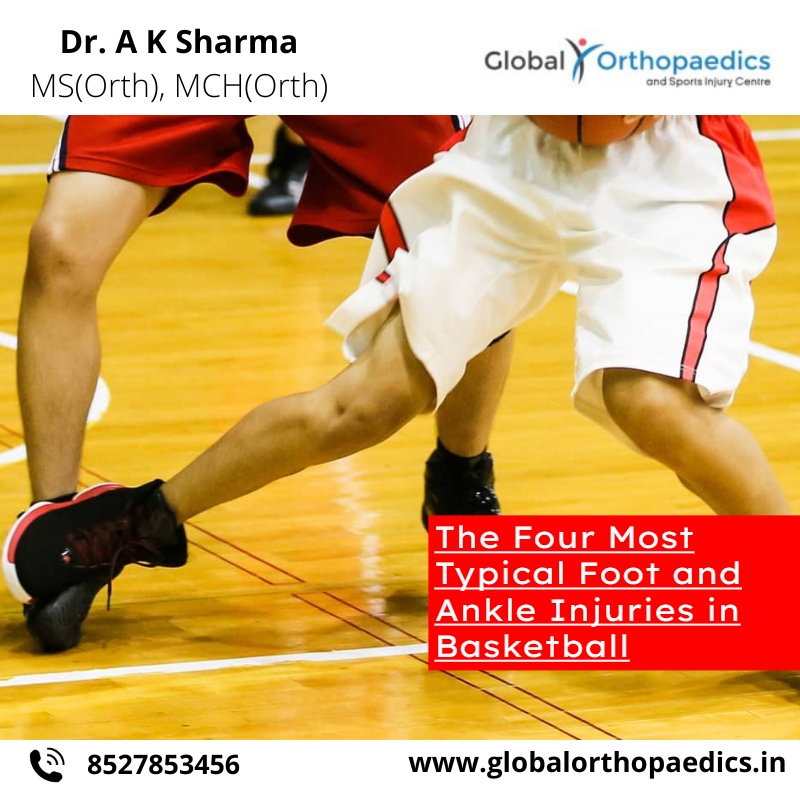When playing the sport of basketball, athletes exert a lot of strain on their ankles and feet. Bones, ligaments, and tendons can be seriously damaged by injuries to the foot and ankle region, forcing athletes to sit out for at least a week.

The four most typical foot and ankle injuries sustained when playing basketball will be covered, along with how to treat them.
Plantar Fasciitis
One of the most often injured parts of the foot is the plantar fascia, which runs from the heel bone to the tips of the toes. Running is one repeated action that can irritate this region of the foot. The foot’s heel region may experience pain if the area is irritated.
Treatment:
- As your doctor has instructed, get plenty of rest
- Apply ice to the region to reduce swelling
- Utilise anti-inflammatory drugs
- Exercise
- Utilising shoe inserts
- Injections of cortisone
Prevention:
- Every time you engage in particular actions like jogging, walking, standing, or sitting, relax your lower legs.
- When you leap, attempt to land on your foot’s midsection rather than its heel.
Achilles Tendonitis
The thick fibrous structure known as the Achilles tendon attaches the calf muscles to the heel. When playing basketball, players frequently walk, run, and leap using this part of their foot. Players are hence more susceptible to suffering this form of foot injury.
Repetitive strain and tension lead to Achilles tendinitis. Inflammation in the region can cause a number of symptoms, including pain, stiffness, and edoema. The Achilles tendon can occasionally rip if it is put under too much strain.
Treatment:
- Rest, ice, compression, and elevation is known as RICE treatment.
- Utilise over-the-counter pain relievers, but in case the discomfort is unbearable, consult your foot specialist for a prescription.
- Heat and ice treatment
- Physical exercise
- Immobilization of the ankle
Prevention:
- Warm up and cool down frequently, especially before and after a game of basketball.
- Use the right strength-training methods for your shoulders, lower back, and legs.
- Work on your equilibrium.
- Wear supportive footwear
- Include one or two days of rest each week.
Sprained Ankles
When the foot rolls or twists more forcibly than it should, an ankle sprain results. An ankle sprain may result in discomfort, soreness, instability, bruising, and swelling as well as partial or complete damage to the ankle’s fibres and ligaments.
Treatment:
- Rest, ice, compression, and elevation, or RICE, therapy
- NSAIDs are non-steroidal anti-inflammatory medicines.
- crutches as necessary
- Immobilization
- Physical therapy
Prevention:
- Before beginning any physical exercise, warm up.
- Take care when running or walking, especially when the ground is uneven.
- Put on the appropriate footwear for the game.
- When you experience discomfort or exhaustion, take a rest.
Stress Fractures
Small fissures in a bone called stress fractures are brought on by overuse and repeated motion. They typically happen when a sportsperson abruptly switches to high-intensity training. Tiny fractures in the bone occur when muscles are fatigued because the bones are no longer able to absorb all the strain and shock. Some signs include swelling, discomfort, bruising, soreness that increases with physical activity and decreases after rest.
Treatment:
- Rest, ice, compression, and elevation, or RICE, therapy
- Wearing a cast
Prevention:
- Consume a diet high in calcium and vitamin D to strengthen your bones.
- Putting on safety shoes
- Begin new fitness routines gradually.
If any of the below have happened to you, seek out the best sports injury doctor in Noida:
- When you were hurt, a “pop” noise was heard.
- Your ankle or foot started to hurt right away, and the swelling persisted for a few days after that.
- Even when you start walking again, your ankle continues to be unstable.
Make an appointment with your doctor at the best sports injury clinic in Delhi NCR to receive specialized treatment with a personal approach.


